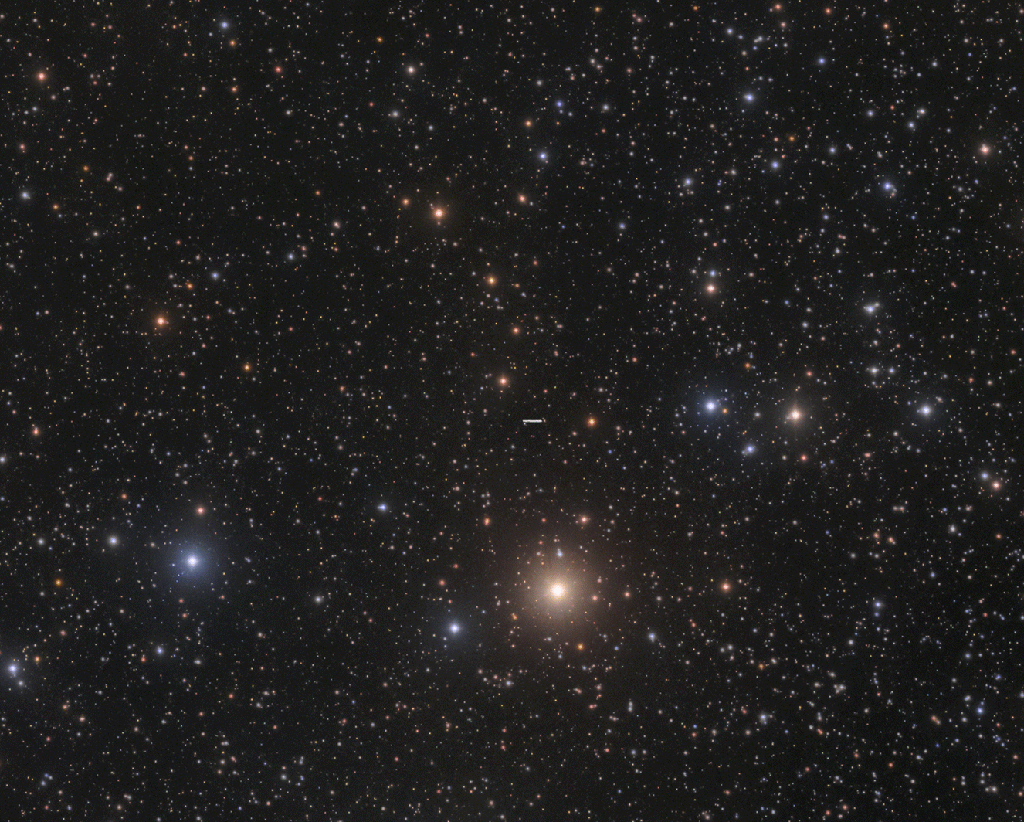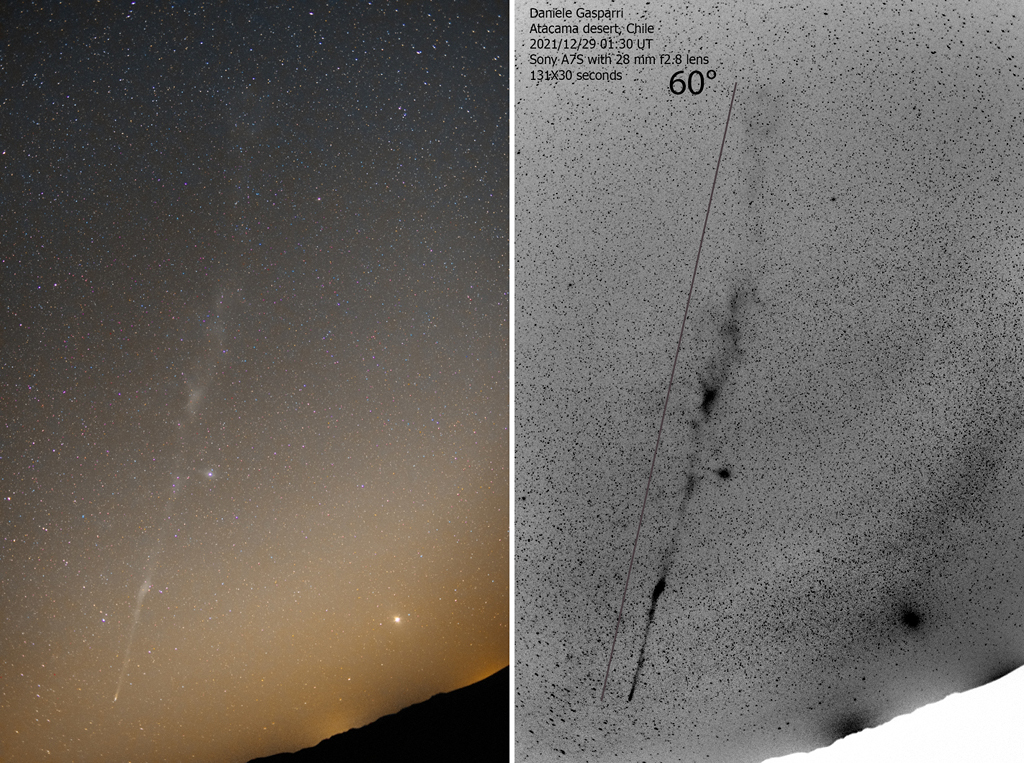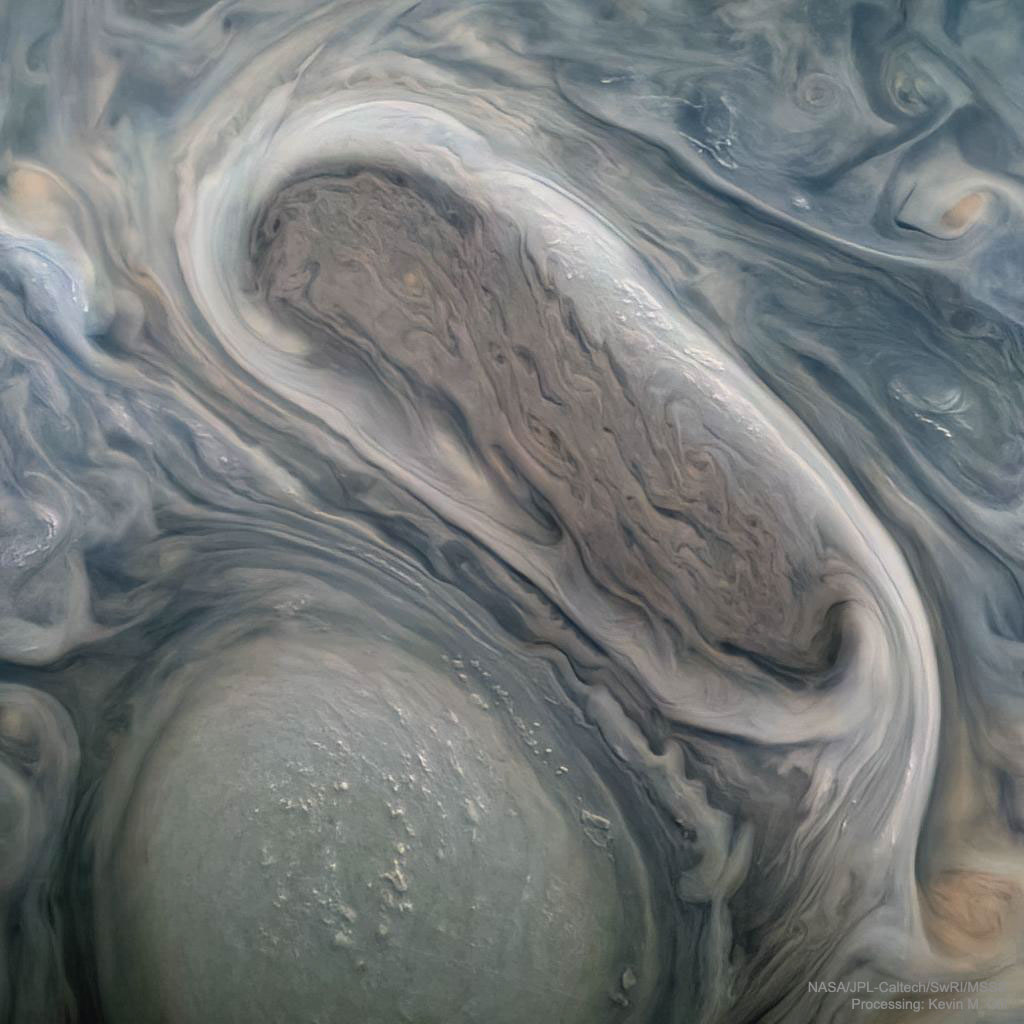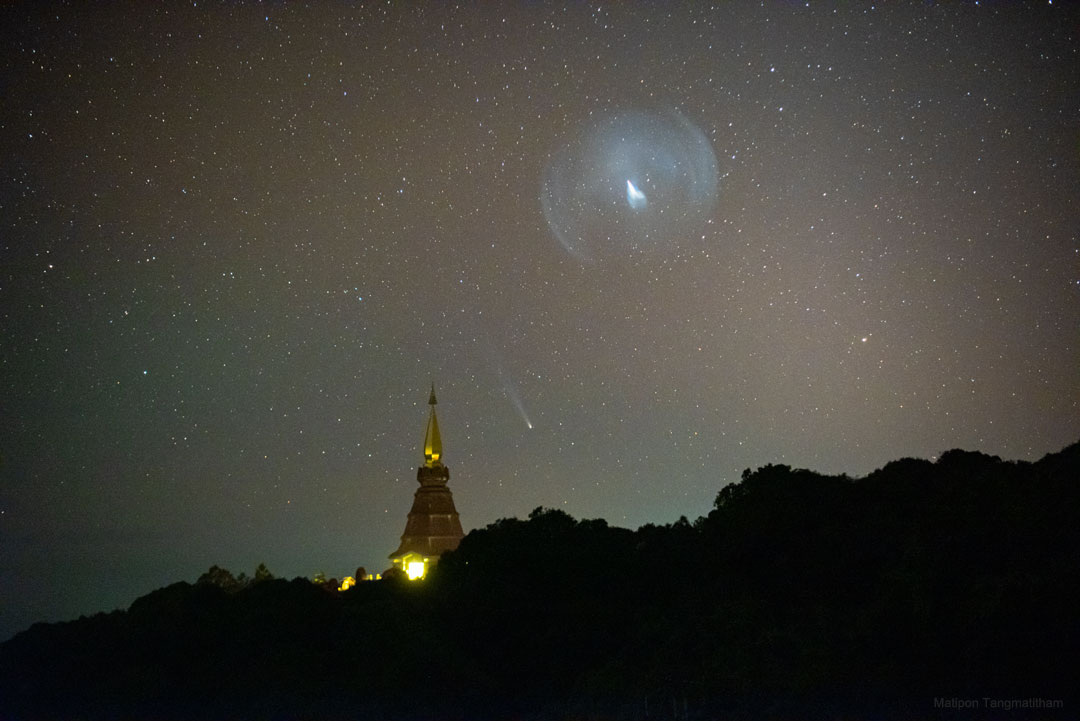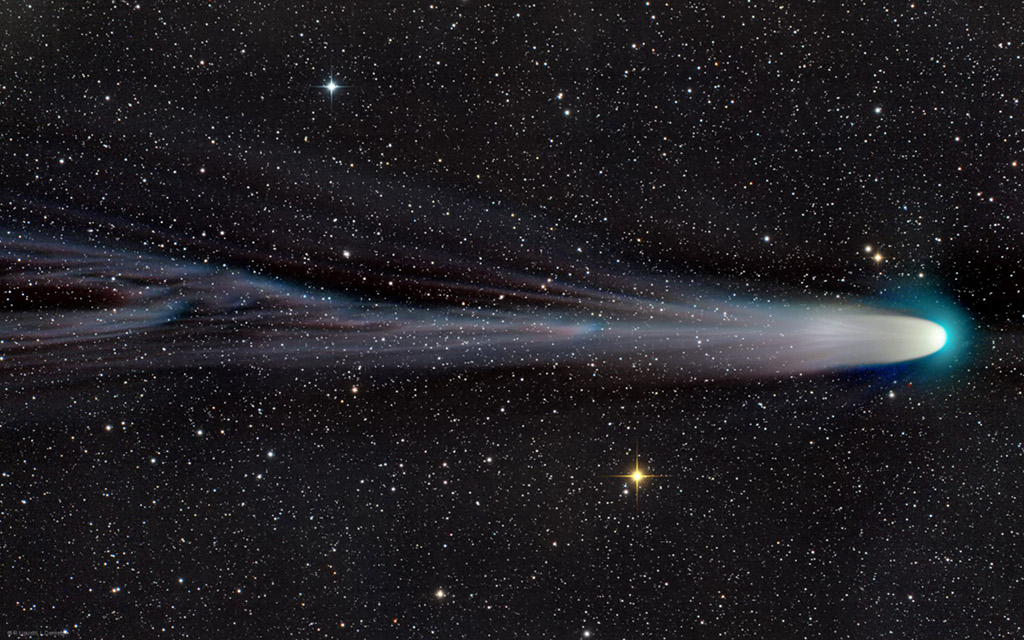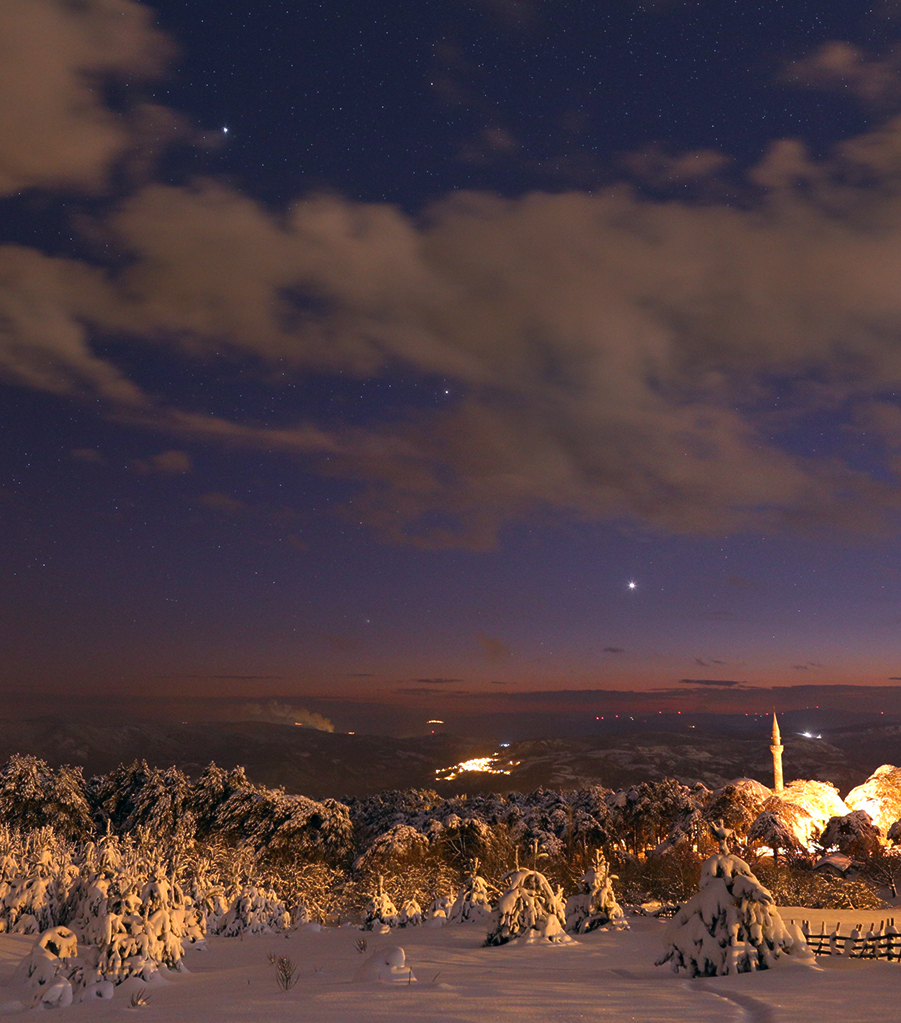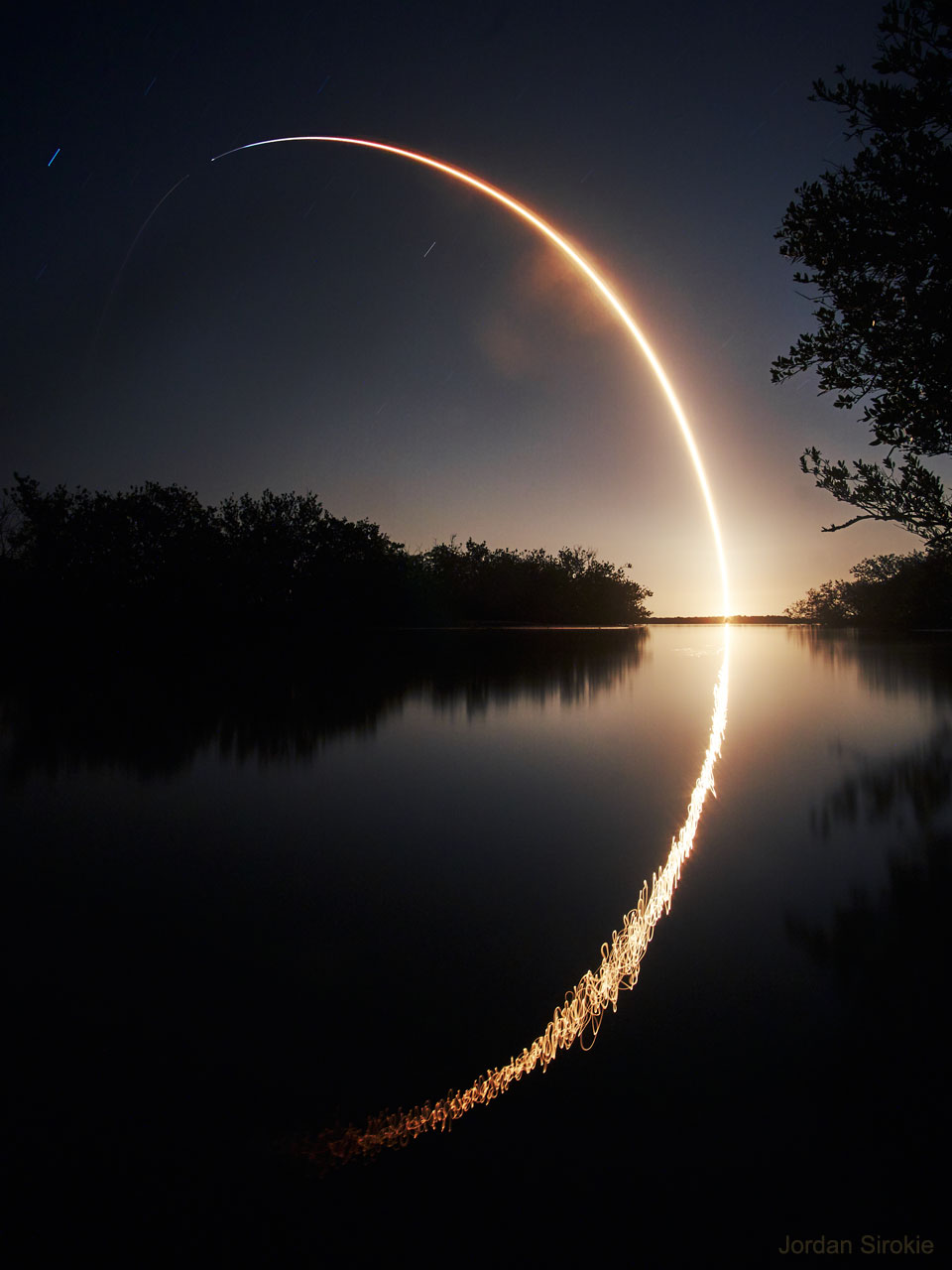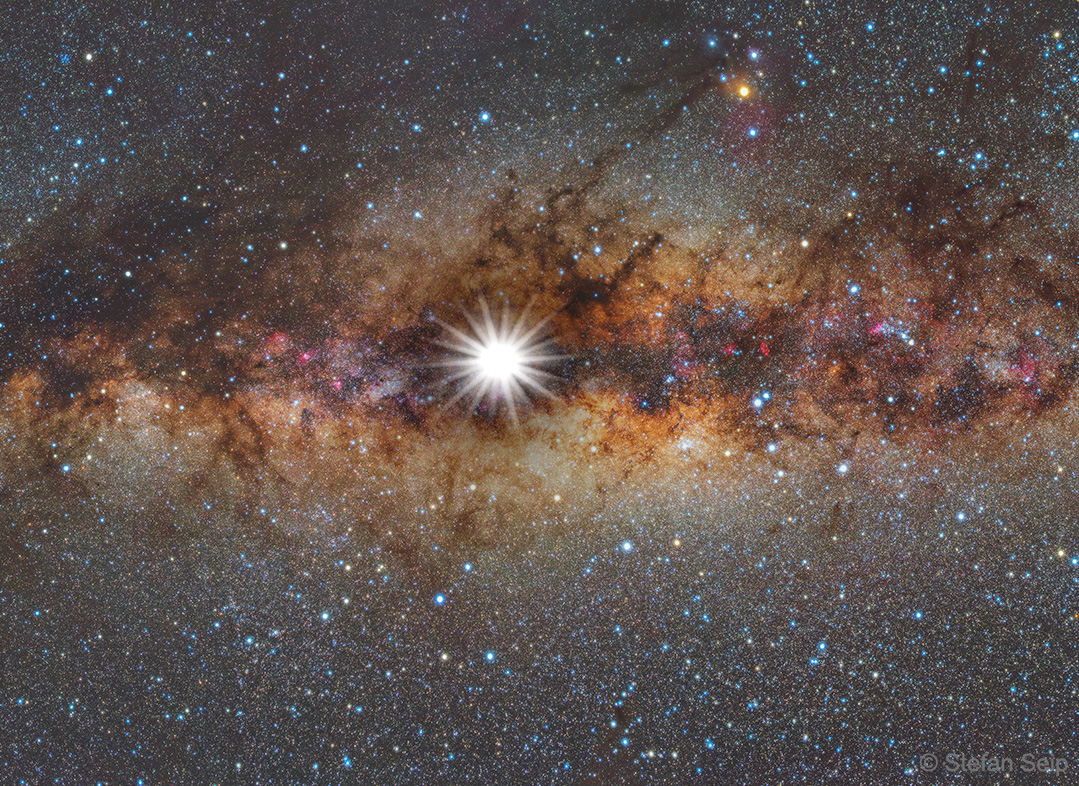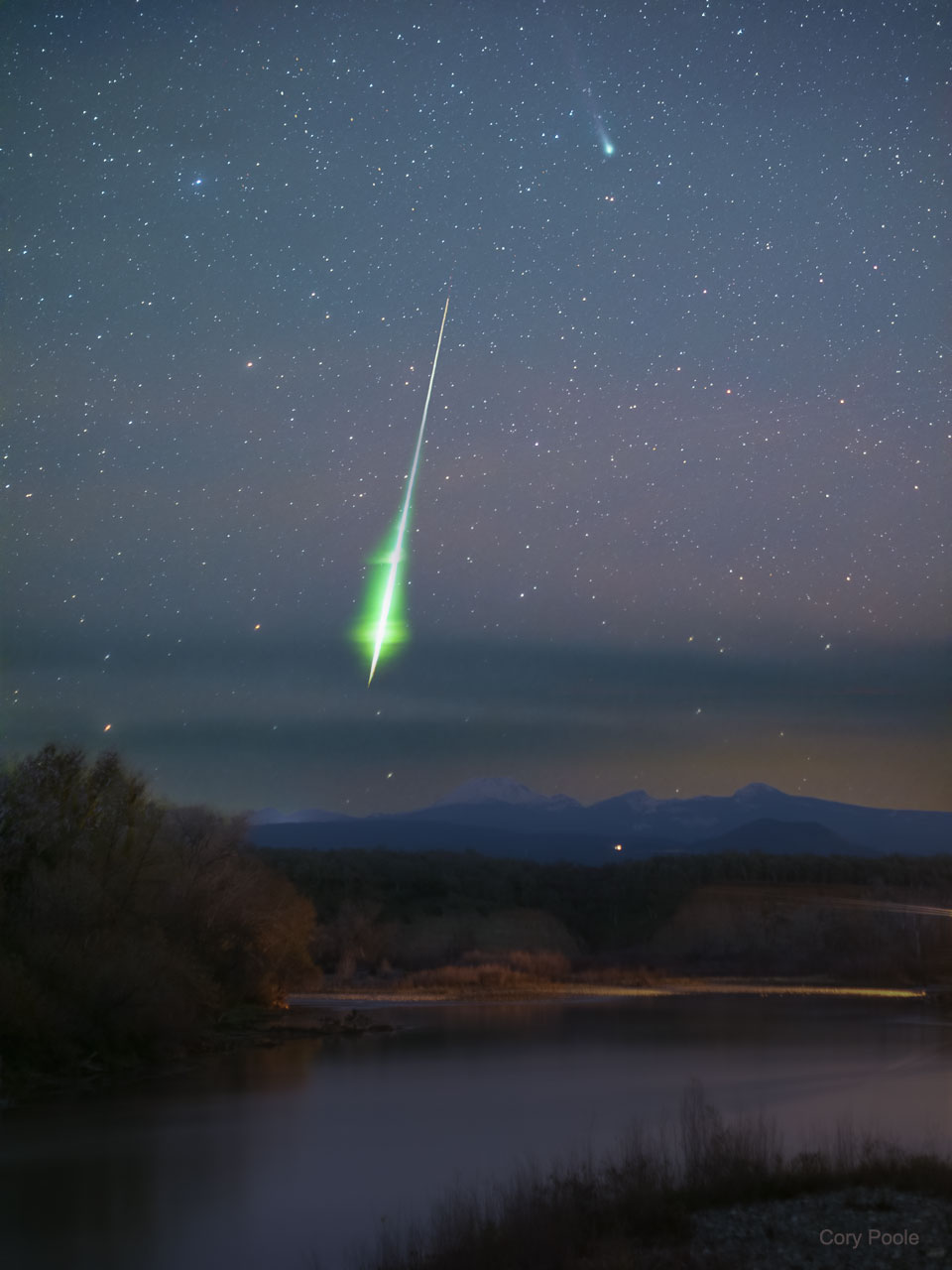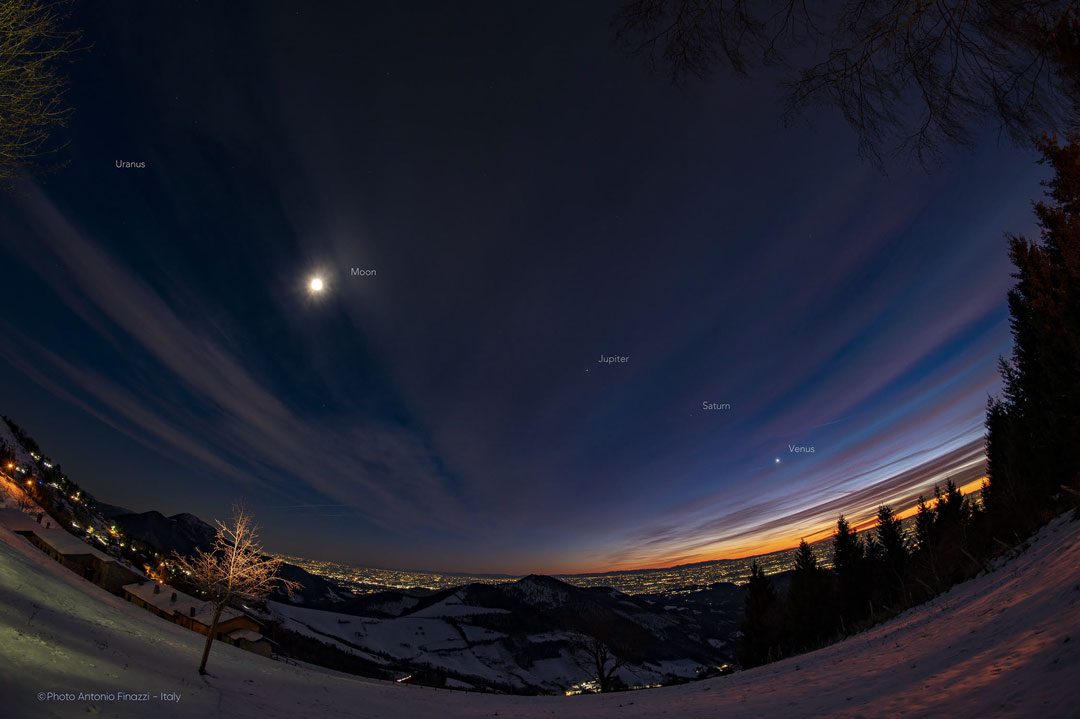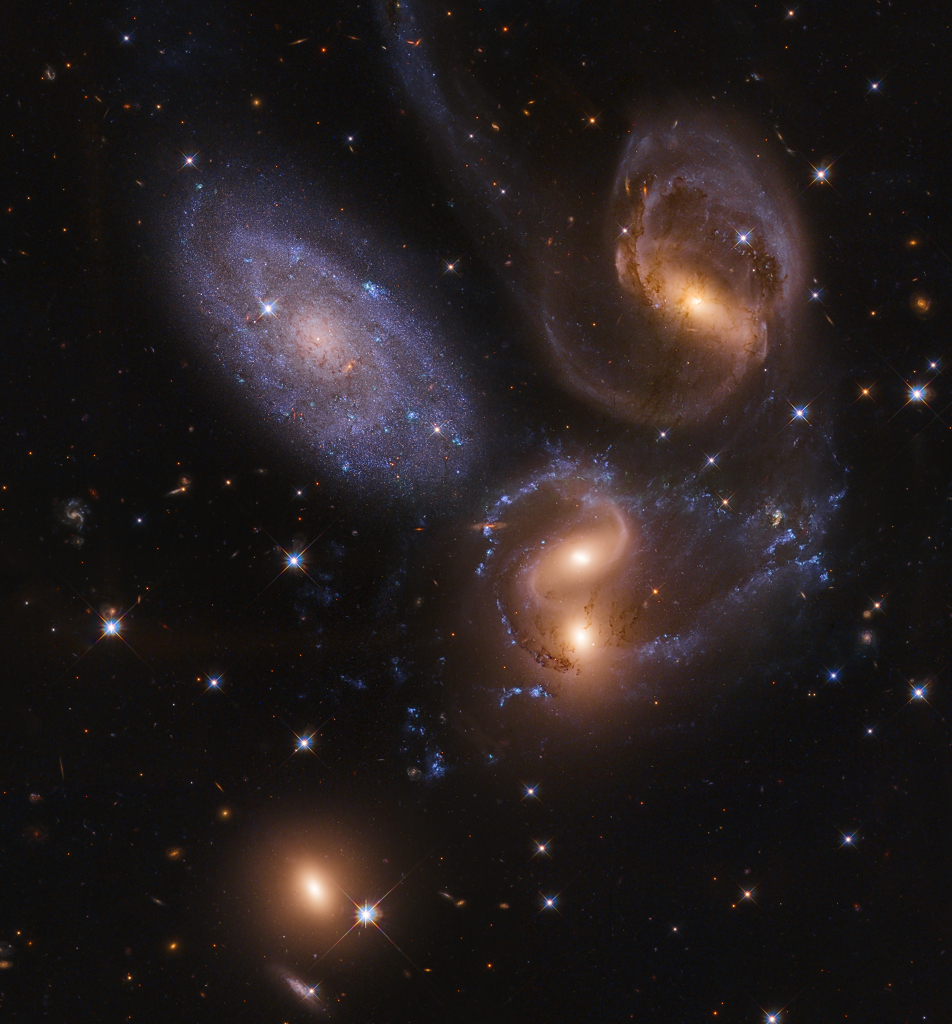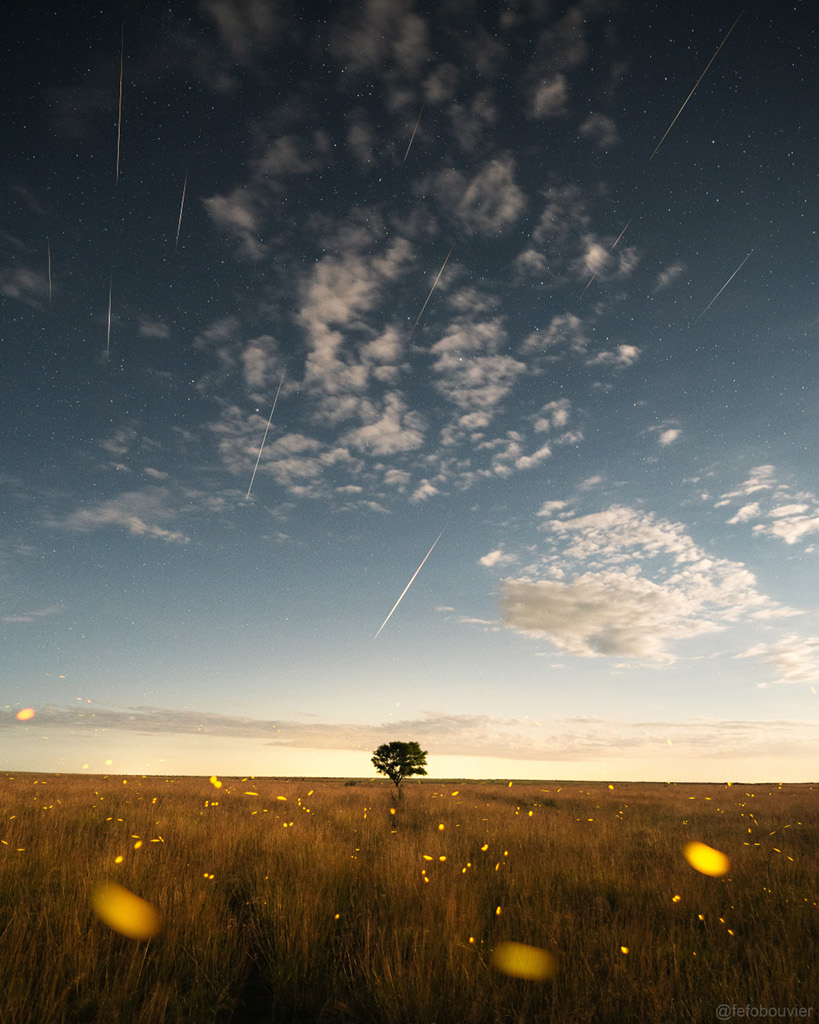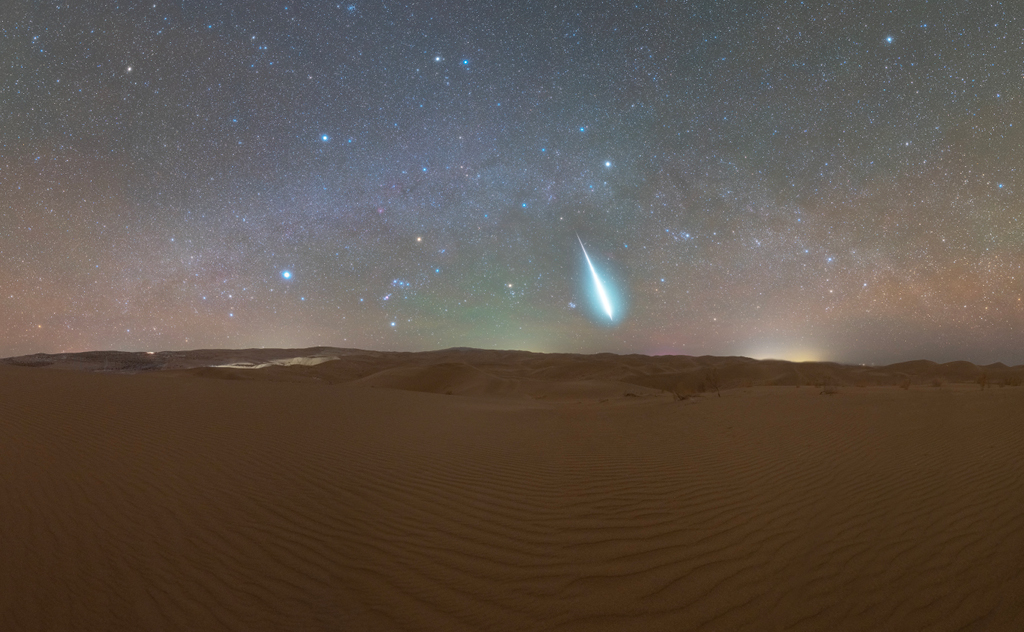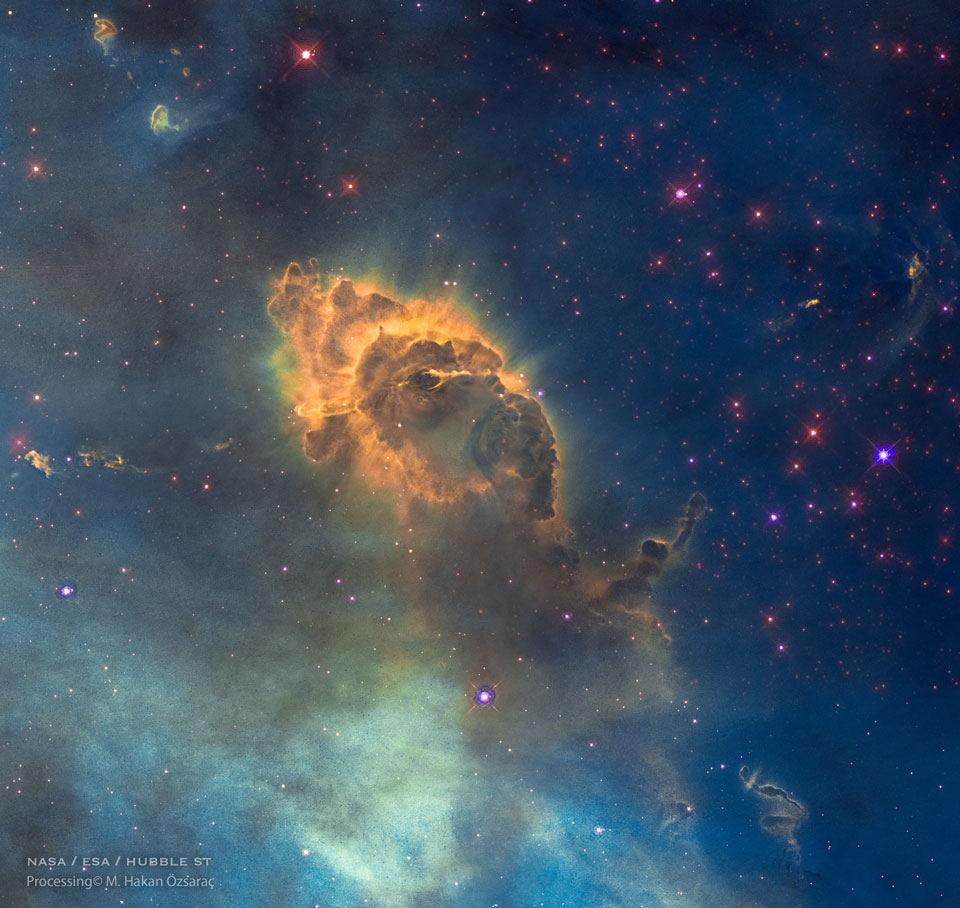Nombre total de pages vues
31/12/2021
ASTRONOMY - JWST on the Road to L2
2021 December 31
Image Credit & Copyright: Malcolm Park (North York Astronomical Association)
Explanation: This timelapse gif tracks the James Webb Space Telescope as it streaks across the stars of Orion on its journey to a destination beyond the Moon. Recorded on December 28, 12 consecutive exposures each 10 minutes long were aligned and combined with a subsequent color image of the background stars to create the animation. About 2.5 days after its December 25 launch, JWST cruised past the altitude of the Moon's orbit as it climbed up the gravity ridge from Earth to reach a halo orbit around L2, an Earth-Sun Lagrange point. Lagrange points are convenient locations in space where the combined gravitational attraction of one massive body (Earth) orbiting another massive body (Sun) is in balance with the centripetal force needed to move along with them. So much smaller masses, like spacecraft, will tend to stay there. One of 5 Lagrange points, L2 is about 1.5 million kilometers from Earth directly along the Earth-Sun line. JWST will arrive at L2 on January 23, 29 days after launch. While relaxing in Earth's surface gravity you can follow the James Webb Space Telescope's progress and complicated deployment online.
30/12/2021
ASTRONOMY - The Further Tail of Comet Leonard
2021 December 30
Image Credit & Copyright: Daniele Gasparri
Explanation: Comet Leonard, brightest comet of 2021, is at the lower left of these two panels captured on December 29 in dark Atacama desert skies. Heading for its perihelion on January 3 Comet Leonard's visible tail has grown. Stacked exposures with a wide angle lens (also displayed in a reversed B/W scheme for contrast), trace the complicated ion tail for an amazing 60 degrees, with bright Jupiter shining near the horizon at lower right. Material vaporizing from Comet Leonard's nucleus, a mass of dust, rock, and ices about 1 kilometer across, has produced the long tail of ionized gas fluorescing in the sunlight. Likely flares on the comet's nucleus and buffeting by magnetic fields and the solar wind in recent weeks have resulted in the tail's irregular pinched and twisted appearance. Still days from its closest approach to the Sun, Comet Leonard's activity should continue. The comet is south of the Solar System's ecliptic plane as it sweeps through the southern constellation Microscopium.
RADIOACITIVITé - CRIIRAD - Qu'est-ce que la radioactivité - 1 -
29/12/2021
ASTRONOMY - Giant Storms and High Clouds on Jupiter
2021 December 29
Image Credit: NASA/JPL-Caltech/SwRI/MSSS; Processing & License: Kevin M. Gill
Explanation: What and where are these large ovals? They are rotating storm clouds on Jupiter imaged last month by NASA's Juno spacecraft. In general, higher clouds are lighter in color, and the lightest clouds visible are the relatively small clouds that dot the lower oval. At 50 kilometers across, however, even these light clouds are not small. They are so high up that they cast shadows on the swirling oval below. The featured image has been processed to enhance color and contrast. Large ovals are usually regions of high pressure that span over 1000 kilometers and can last for years. The largest oval on Jupiter is the Great Red Spot (not pictured), which has lasted for at least hundreds of years. Studying cloud dynamics on Jupiter with Juno images enables a better understanding of dangerous typhoons and hurricanes on Earth.
ART FRACTAL - Kevin R. Johnson, DR - Un arbre brownien né de sulfate de cuivre
SANTE/MEDECINE - Comment mieux dormir - Pas de sport le soir (2)
Doctissimo
28/12/2021
SANTE/MEDECINE - Comment mieux dormir - Evitez la caféine et la théine (1)
Les fans de café vont être déçus, mieux vaut prendre son dernier expresso après le repas de midi. De même, concernant le thé et les boissons au cola, il est préférable de les arrêter après 16h. Il est en effet prouvé que la caféine rallonge le temps d'endormissement et raccourcit le temps de sommeil. A la place, buvez une tisane de plantes apaisantes (tilleul, verveine, camomille ou fleur d'oranger, mais aussi passiflore, valériane, aubépine et houblon), ou un verre de lait tiède qui exerce un effet sédatif.
Doctissimo
AERONAUTIQUE - Avions de légende - Le Concorde
MICROPHOTOGRAPHIE - Marek Mis - De petits monstres sous vitamine C
ART FRACTAL - Et design - © Stocklady, Shutterstock
© Stocklady, Shutterstock
ASTRONOMY - Sun Halo over Sweden
2021 December 28
Video Credit & Copyright: Håkan Hammar (Vemdalen Ski Resort, SkiStar)
Explanation: What's happened to the Sun? Sometimes it looks like the Sun is being viewed through a giant lens. In the featured video, however, there are actually millions of tiny lenses: ice crystals. Water may freeze in the atmosphere into small, flat, six-sided, ice crystals. As these crystals flutter to the ground, much time is spent with their faces flat and parallel to the ground. An observer may find themselves in the same plane as many of the falling ice crystals near sunrise or sunset. During this alignment, each crystal can act like a miniature lens, refracting sunlight into our view and creating phenomena like parhelia, the technical term for sundogs. The featured video was taken in late 2017 on the side of a ski hill at the Vemdalen Ski Resort in central Sweden. Visible in the center is the most direct image of the Sun, while two bright sundogs glow prominently from both the left and the right. Also visible is the bright 22 degree halo -- as well as the rarer and much fainter 46 degree halo -- also created by sunlight refracting through atmospheric ice crystals.
MINERAUX - Le gypse
27/12/2021
MICROPHOTOGRAPHIE - Marek Mis - Un labyrinthe de formes géométriques
MUSIC - Elgar Nimrod - Daniel Barenboim & Chicago Symphony Orchestra - Enigma variations
ASTRONOMY - Comet Leonard behind JWST Launch Plume
2021 December 27
Image Credit & Copyright: Matipon Tangmatitham (NARIT)
Explanation: Which one of these two streaks is a comet? Although they both have comet-like features, the lower streak is the only real comet. This lower streak shows the coma and tail of Comet Leonard, a city-sized block of rocky ice that is passing through the inner Solar System as it continues its looping orbit around the Sun. Comet Leonard has recently passed its closest to both the Earth and Venus and will round the Sun next week. The comet, still visible to the unaided eye, has developed a long and changing tail in recent weeks. In contrast, the upper streak is the launch plume of the Ariane V rocket that lifted the James Webb Space Telescope (JWST) off the Earth two days ago. The featured single-exposure image was taken from Thailand, and the foreground spire is atop a pagoda in Doi Inthanon National Park. JWST, NASA's largest and most powerful space telescope so far, will orbit the Sun near the Earth-Sun L2 point and is scheduled to start science observations in the summer of 2022.
26/12/2021
MICROPHOTOGRAPHIE - Marek Mis - Alliance d’un médicament et d’un additif alimentaire
25/12/2021
MINERAUX - La crocoïte
ASTRONOMY - The Tail of a Christmas Comet
Image Credit & Copyright: Rolando Ligustri (CARA Project, CAST) and Lukas Demetz
Explanation: The tail of a comet streams across this three degree wide telescopic field of view captured under dark Namibian skies on December 21. In outburst only a few days ago and just reaching naked eye visibility Comet Leonard (C/2021 A1) is this year's brightest comet. Binoculars will make the diffuse comet easier to spot though, close to the western horizon after sunset. Details revealed in the sharp image show the comet's coma with a greenish tinge, and follow the interaction of the comet's ion tail with magnetic fields in the solar wind. After passing closest to Earth on December 12 and Venus on December 18, Comet Leonard is heading toward perihelion, its closest approach to the Sun on January 3rd. Appearing in late December's beautiful evening skies Comet Leonard has also become known as 2021's Christmas Comet.
AERONAUTIQUE - Avions de légende - Le Boeing B-29 Superfortress

23/12/2021
ASTRONOMY - Three Planets and a Comet
2021 December 23
Image Credit & Copyright: Tunc Tezel (TWAN)
Explanation: Are you still looking for that perfect holiday gift for an astronomer? If your night sky is dark and horizon clear enough, the Solar System may have done your shopping for you. Send them outside after sunset to see three planets and a comet. In this snapshot of the December solstice evening sky from the village of Kirazli, Turkey the brightest celestial beacon is Venus, close to the southwestern horizon at the right. Look left and up to find Saturn shining between clouds. Follow that line farther left and up to bright Jupiter, the Solar System's ruling gas giant. This year's surprise visitor to the inner Solar System, Comet Leonard (C/2021 A1), is near the horizon too. The comet is fainter but forms a nearly equilateral triangle with planets Venus and Saturn in this view. After a dramatic brightening in recent days the comet is just visible to the unaided eye, though a nice pair of binoculars is always a good idea.
22/12/2021
ASTRONOMY - Launch of the IXPE Observatory
2021 December 22
Image Credit & Copyright: Jordan Sirokie
Explanation: Birds don't fly this high. Airplanes don't go this fast. The Statue of Liberty weighs less. No species other than human can even comprehend what is going on, nor could any human just a millennium ago. The launch of a rocket bound for space is an event that inspires awe and challenges description. Pictured here, a SpaceX Falcon 9 rocket lifted off from Kennedy Space Center, Florida earlier this month carrying the Imaging X-ray Polarimetry Explorer (IXPE). IXPE is scheduled to observe high-energy objects such as neutron stars, black holes, and the centers of distant galaxies to better determine the physics and geometries that create and control them. From a standing start, the 300,000+ kilogram rocket ship lifted IXPE up to circle the Earth, where the outside air is too thin to breathe. Rockets bound for space are now launched from somewhere on Earth every few days.
21/12/2021
ASTRONOMY - Solstice Sun and Milky Way
2021 December 21
Composite Image Credit & Copyright: Stefan Seip (TWAN)
Explanation: Welcome to December's solstice, first day of winter in the north and summer for the southern hemisphere. Astronomical markers of the seasons, solstice and equinox dates are based on the Sun's place in its annual journey along the ecliptic, through planet Earth's sky. At this solstice, the Sun reaches its maximum southern declination of -23.5 degrees today at 15:59 UTC, while its right ascension coordinate on the celestial sphere is 18 hours. That puts the Sun in the constellation Sagittarius in a direction near the center of our Milky Way galaxy. In fact, if you could see today's Solstice Sun against faint background stars and nebulae (that's really hard to do, especially in the daytime ...) your view might look something like this composited panorama. To make it, images of our fair galaxy were taken under dark Namibian night skies, then stitched together in a panoramic view. From a snapshot made on 2015 December 21, the Sun was digitally overlayed as a brilliant star at today's northern winter solstice position, close to the center of the Milky Way.
SOLSTICES - Le solstice d'hiver est aujourd'hui à 16 h 59 !
SCIENCE - Minéraux - L’anglésite, une pierre de plomb
20/12/2021
ASTRONOMY - The Comet and the Fireball
2021 December 20
Image Credit & Copyright: Cory Poole
Explanation: This picture was supposed to feature a comet. Specifically, a series of images of the brightest comet of 2021 were being captured: Comet Leonard. But the universe had other plans. Within a fraction of a second, a meteor so bright it could be called a fireball streaked through just below the comet. And the meteor's flash was even more green than the comet's coma. The cause of the meteor's green was likely magnesium evaporating from the meteor's pebble-sized core, while the cause of the comet's green was likely diatomic carbon recently ejected from the comet's city-sized nucleus. The images were taken 10 days ago over the Sacramento River and Mt. Lassen in California, USA. The fireball was on the leading edge of this year's Geminid Meteor Shower -- which peaked a few days later. Comet Leonard is now fading after reaching naked-eye visibility last week -- but now is moving into southern skies.
19/12/2021
ASTRONOMY - Planetary Alignment over Italy
2021 December 19
Image Credit & Copyright: Antonio Finazzi
Explanation: It is not a coincidence that planets line up. That's because all of the planets orbit the Sun in (nearly) a single sheet called the plane of the ecliptic. When viewed from inside that plane -- as Earth dwellers are likely to do -- the planets all appear confined to a single band. It is a coincidence, though, when three of the brightest planets all appear in nearly the same direction. Such a coincidence was captured earlier this month. Featured above (right to left), Venus, Saturn, and Jupiter were all imaged together in a line just after sunset, from the San Fermo Hills, Bergamo, Italy. Joining the alignment are Earth's Moon, and the position of the more distant Uranus. Bands of clouds streak across the sky toward the setting Sun. As Comet Leonard fades, this planetary alignment -- absent the Moon -- should persist for the rest of the month.
AERONAUTIQUE - Avions de légende - Le Spirit of St. Louis (l'avion de Charles Lindbergh)
 |
18/12/2021
AERONAUTIQUE - Avions de légende - Le Fokker Dr.I, l’avion du Baron Rouge
ASTRONOMY - Stephan's Quintet
2021 December 18
Image Credit: NASA, ESA, Hubble Legacy Archive;
Processing & Copyright: Bernard Miller
Explanation: The first identified compact galaxy group, Stephan's Quintet is featured in this eye-catching image constructed with data drawn from the extensive Hubble Legacy Archive. About 300 million light-years away, only four of these five galaxies are actually locked in a cosmic dance of repeated close encounters. The odd man out is easy to spot, though. The interacting galaxies, NGC 7319, 7318A, 7318B, and 7317 have an overall yellowish cast. They also tend to have distorted loops and tails, grown under the influence of disruptive gravitational tides. But the predominantly bluish galaxy, NGC 7320, is closer, just 40 million light-years distant, and isn't part of the interacting group. Stephan's Quintet lies within the boundaries of the high flying constellation Pegasus. At the estimated distance of the quartet of interacting galaxies, this field of view spans about 500,000 light-years. But moving just beyond this field, up and to the right, astronomers can identify another galaxy, NGC 7320C, that is also 300 million light-years distant. Including it would bring the interacting quartet back up to quintet status.
17/12/2021
ASTRONOMY - Geminids of the South
2021 December 16
Image Credit & Copyright: Fefo Bouvier
Explanation: Fireflies flash along a moonlit countryside in this scene taken on the night of December 13/14 from southern Uruguay, planet Earth. On that night meteors fell in the partly cloudy skies above during the annual Geminid meteor shower. Frames recorded over a period of 1.5 hours are aligned in the composite image made with the camera facing south. That direction was opposite the shower's radiant toward the north and so the Geminid meteor streaks appear to converge at an antiradiant below the southern horizon. The shower's apparent radiant (and antiradiant) is just due to perspective though. As Earth sweeps through the dust trail of mysterious asteroid 3200 Phaethon, the dust grains that create the Geminid shower meteors are really moving along parallel tracks. They enter Earth's atmosphere traveling at about 22 kilometers per second.
AERONAUTIQUE - Avions de légende - Le Stampe SV-4
ASTRONOMY - Geminid of the North
2021 December 17
Image Credit & Copyright: Alvin Wu
Explanation: An arid expanse of the Tengger Desert in north-central China, planet Earth fills the foreground of this starry scene. A widefield panoramic view, it was recorded shortly after moonset in the local predawn hours of December 14. Pictured in the still dark sky, stars of the northern winter hexagon surround a luminous Milky Way. Seen near the peak of the annual meteor shower, the startling flash of a bright Geminid fireball meteor was also captured on that night. Above the western horizon and just below bright star Capella, its dagger-like trail points back to the meteor shower's radiant in Gemini. Of course, the constellation Gemini is easy to spot. Its twin bright stars, bluish Castor and yellowish Pollux are near top center in the frame.
15/12/2021
ASTRONOMY - Comet Leonard from Space
2021 December 15
Image Credit & Copyright: Zhuoxiao Wang, Yangwang-1 Space Telescope, Origin.Space
Explanation: What does Comet Leonard look like from space? Today's featured image from Origin.Space's Yangwang-1 space telescope shows not only the currently bright comet -- but several other space delights as well. Taken in optical and ultraviolet light, C/2021 A1 (Leonard) is visible with an extended tail near the image center as it appeared five days ago. The Earth is visible on the lower right, while layers of the Earth's atmosphere glow diagonally from the lower left to the upper right. The trails of two satellites can be seen in front of a myriad of distant stars that dot the background on the upper left. The faint bands of light running diagonally from the lower right to the upper left are auroras. Finally, the image also caught a meteor streaking just below the airglow. To see Comet Leonard yourself from the Earth's surface during the next few days, look toward the western horizon just after sunset or just before sunrise.
14/12/2021
ASTRONOMY - HH 666: Carina Dust Pillar with Jet
2021 December 14
Image Credit: NASA, ESA, Hubble; Processing & Copyright: Mehmet Hakan Özsaraç
Explanation: To some, it may look like a beehive. In reality, the featured image from the Hubble Space Telescope captures a cosmic pillar of dust, over two-light years long, inside of which is Herbig-Haro 666 -- a young star emitting powerful jets. The structure lies within one of our galaxy's largest star forming regions, the Carina Nebula, shining in southern skies at a distance of about 7,500 light-years. The pillar's layered outline are shaped by the winds and radiation of Carina's young, hot, massive stars, some of which are still forming inside the nebula. A dust-penetrating view in infrared light better shows the two, narrow, energetic jets blasting outward from a still hidden infant star.
AERONAUTIQUE - Avions de légende - Le Messerschmitt Bf 109
13/12/2021
ASTRONOMIE - Cette nuit, une pluie d'étoiles
Bien qu'il fasse froid, les longues nuits de décembre sont resplendissantes (surtout cette année avec des planètes alignées et une comète) et réservent de beaux spectacles célestes. Parmi eux figurent les Géminides. Une pluie d'étoiles filantes qui s'étend du 19 novembre jusqu'à la veillée de Noël, et est unanimement considérée comme l'une des plus belles, si ce n'est LA plus belle de l'année ! Lors de son pic d'activité, attendu vers le 13-14 décembre, le nombre de météores plongeant dans l'atmosphère peut dépasser les 60 en une heure !
SANTé/MEDECINE - Virus et bactéries mortels - Le virus de la rage
Grâce aux travaux de Louis Pasteur , la rage a très nettement reculé dans le monde. On dénombre tout de même plus de 50.000 morts humains s...

-
2021 May 11 Lightning and Orion Beyond Uluru Image Credit & Copyright: Park Liu Explanation: What's happening behind Uluru? A Un...
-
The Witch Head Nebula Image Credit & Copyright: Digitized Sky Survey (POSS II); Processing: Utkarsh Mishra Explanation: ...

